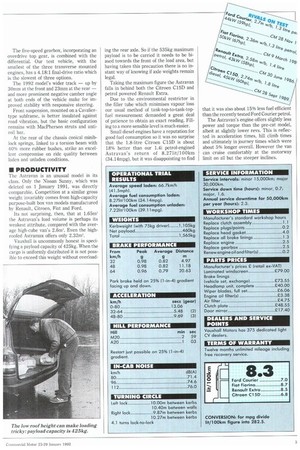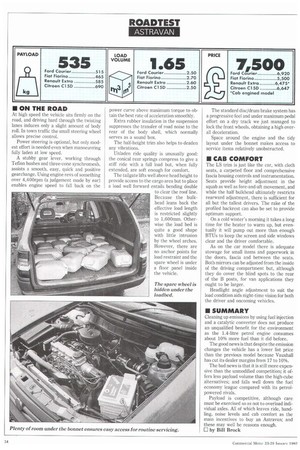• Ten years ago you could buy an Astravan for
Page 34

Page 35

Page 36

If you've noticed an error in this article please click here to report it so we can fix it.
as little as £.3,750; nowadays an Astravan can set you back as much as £7,950.
So what's changed in that time, besides inflation? Almost everything. Vauxhall no longer has a dedicated basic van model; the latest estate-based version, with a more rounded front and rear profile, appeared on the streets at the end of last year. It claimed to set new standards in cab comfort, refinement, handling and driveability, safety and vehicle security and it shares most of the car model's major advances.
• PROFILE Vauxhall claims some light van firsts for the Astravan, including front seatbelt tensioners and side impact protection door beams. Other equipment includes fuel injection with catalytic converters on all petrolengined models, a cabin pollen filter and, as an option, security deadlocks can be specified on all doors including the tailgate.
Safety should also be improved by reinforced door surrounds which are said to increase bodyshell torsional stiffness by 34%. And at £132.73 the deadlock option is well worth considering for high-value loads, as is the identically priced central alarm system.
There are five models to choose from offering two trim standards and three engine options. The Merit's lower trim specification uses vinyl seats, which can be cold on a winter's morning and are sweaty in summer. Their only justification is that they are easier to clean, but that's not sufficient reason to impose them on anyone.
The lower powered 1.4i petrol and 1.7litre diesel engines, both rated at 45kW (60hp), are available with the Merit; the LS can also take the 67kW (92hp) 1.6i petrol engine. Vauxhall has made catalytic converters standard for both petrol engines and, to date, this is the only way to meet the emission standards that become mandatory for new cars and vans registered after December 1992, The five-speed gearbox, incorporating an overdrive top gear, is combined with the differential. Our test vehicle, with the smallest of the three transverse mounted engines, has a 4.18:1 final-drive ratio which is the slowest of three options.
The 1992 model's wider track up by 30mm at the front and 23mm at the rear and more prominent negative camber angle at both ends of the vehicle make for improved stability with responsive steering.
Front suspension, mounted on a Cavaliertype subframe, is better insulated against road vibration, but the basic configuration remains with MacPherson struts and antiroll bar.
At the rear of the chassis conical miniblock springs, linked to a torsion beam with 40% more rubber bushes, strike an excellent compromise on ride quality between laden and unladen conditions.
• PRODUCTIVITY
The Astravan is an unusual model in its class. Only the Nissan Sunny, which was deleted on 1 January 1991, was directly comparable. Competition at a similar gross weight invariably comes from high-capacity purpose-built box van models manufactured by Renault, Citroen, Fiat and Ford.
Its not surprising, then, that at 1.65m" the Astravan's load volume is perhaps its weakest attribute, compared with the average high-cube van's 2.6m. Even the highroofed Astramax offers only 2.32m".
Vauxhall is uncommonly honest in specifying a payload capacity of 425kg. When the cargo is uniformly distributed it is not possible to exceed this weight without overload
ing the rear axle. So if the 535kg maximum payload is to be carried it needs to be biased towards the front of the load area, but having taken this precaution there is no instant way of knowing if axle weights remain legal.
Taking the maximum figure the Astravan falls in behind both the Citroen C15D and petrol powered Renault Extra.
Due to the environmental restrictor in the filler tube which minimises vapour loss our usual method of tank-top-to-tank-topfuel measurement demanded a great deal of patience to obtain an exact reading. Filling to a more sensible level is much easier.
Small diesel engines have a reputation for good fuel consumption so it was no surprise that the 1.8-litre Citroen C15D is about 18% better than our 1.4i petrol-engined Astravan's return of 8.271it/100km (34.14mpg), but it was disappointing to find that it was also about 15% less fuel efficient than the recently tested Ford Courier petrol.
The Astravan's engine offers slightly less power and torque than the pre-cat model, albeit at slightly lower revs. This is reflected in acceleration times, hill climb times and ultimately in journey times which were about 5% longer overall. However the van can cruise comfortably at the motorway limit on all but the steeper inclines.
• ON THE ROAD
At high speed the vehicle sits firmly on the road, and driving hard through the twisting lanes induces only a slight amount of body roll. In town traffic the small steering wheel allows precise control.
Power steering is optional, but only modest effort is needed even when manoeuvring fully laden at low speed.
A stubby gear lever, working through Teflon bushes and three-cone synchromesh, assists a smooth, easy, quick and positive gearchange. Using engine revs of something over 4,400rpm (a judgement made by ear) enables engine speed to fall back on the power curve above maximum torque to obtain the best rate of acceleration smoothly.
Extra rubber insulation in the suspension suppresses the transfer of road noise to the rear of the body shell, which normally serves as a sound box.
The half-height trim also helps to deaden any vibrations.
Unladen ride quality is unusually good: the conical rear springs compress to give a stiff ride with a full load but, when fully extended, are soft enough for comfort.
The tailgate lifts well above head height to provide access to the cargo area but to place a load well forward entails bending double to clear the roof line. Because the bulkhead leans back the effective load length is restricted slightly to 1,600mm. Otherwise the load bed is quite a good shape with little intrusion by the wheel arches. However, there are no anchor points for load restraint and the spare wheel is under a floor panel inside the vehicle. The standard disc/drum brake system has a progressive feel and under maximum pedal effort on a dry track we just managed to lock the front wheels, obtaining a high overall deceleration.
Space around the engine and the tidy layout under the bonnet makes access to service items relatively unobstructed.
• CAB COMFORT
The LS trim is just like the car, with cloth seats, a carpeted floor and comprehensive fascia housing controls and instrumentation. Seats provide height adjustment in the squab as well as fore-and-aft movement, and while the half bulkhead ultimately restricts rearward adjustment, there is sufficient for all but the tallest drivers. The rake of the profiled backrest can also be set to provide optimum support.
On a cold winter's morning it takes a long time for the heater to warm up, but eventually it will pump out more than enough BTUs to keep the screen and side windows clear and the driver comfortable.
As on the car model there is adequate stowage for small items and paperwork in the doors, fascia and between the seats. Both mirrors can be adjusted from the inside of the driving compartment but, although they do cover the blind spots to the rear of the B posts, for van applications they ought to be larger.
Headlight angle adjustment to suit the load condition aids night-time vision for both the driver and oncoming vehicles.
• SUMMARY
Cleaning up emissions by using fuel injection and a catalytic converter does not produce an unqualified benefit for the environment as the 1.4-litre petrol engine consumes about 10% more fuel than it did before.
The good news is that despite the emission changes the vehicle has a lower list price than the previous model because Vauxhall has cut its dealer margins from 17 to 10%.
The bad news is that it is still more expensive than the unmodified competition; it offers less payload volume than the high-cube alternatives; and falls well down the fuel economy league compared with its petrolpowered rivals.
Payload is competitive, although care must be exercised so as not to overload individual axles. All of which leaves ride, handling, noise levels and cab comfort as the main incentives to buy an Astravan; and these may well be reasons enough.
0 by Bill Brock
































































































































































